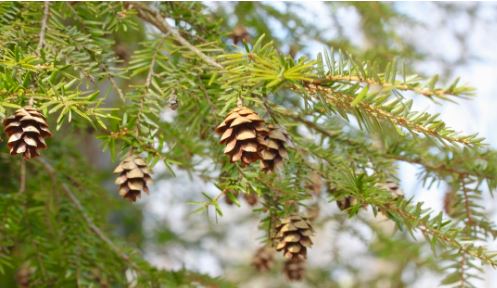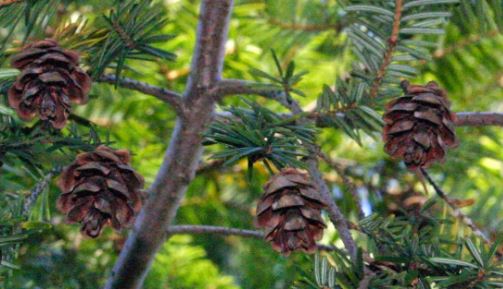
Tsuga is a genus of conifers in the subfamily Abietoideae of Pinaceae, the pine family. The English-language common name “hemlock” arose from a perceived similarity in the smell of its crushed foliage to that of the unrelated plant poison hemlock. Unlike the latter, Tsuga species are not poisonous.
Hemlocks are often tall, with a conical shape when young, becoming more irregular as they age. The branches stem horizontally from the trunk and are usually arranged in flattened sprays that bend downward towards their tips. The young twigs, as well as the distal portions of stem, are flexible and often pendent. The stems are rough with pulvini that persist after the leaves fall. The winter buds are ovoid or globose, usually rounded at the apex and not resinous.
Hemlock trees have short, flat needles that are dark green on top with two white bands underneath. Unlike some other conifers, the needles are usually arranged in a flat spray. They produce small, pendulous cones. The size and shape of these cones can help in identifying the species. The bark is often scaly or deeply furrowed, especially as the tree ages, with a reddish-brown to gray color.
Hemlocks provide critical habitat for various wildlife species. Their dense canopy offers shelter, and in riparian zones, they help in maintaining water temperature for aquatic life like trout. The wood from hemlock trees is used for pulp, construction, and sometimes for making boxes or pallets due to its light weight and relative strength.
Hemlocks generally prefer climates with adequate moisture, often in regions with significant rainfall or in areas where fog contributes to humidity. Many hemlock populations, especially in North America, are under threat from pests like the hemlock woolly adelgid, which has led to significant conservation efforts to preserve these trees.

Hemlock Trees (Distribution, Habitat & Pictures)
North America
Eastern Hemlock (Tsuga canadensis):
- Distribution: Found in eastern North America, from Nova Scotia west to Minnesota, and south along the Appalachian Mountains to northern Georgia and Alabama.
- Habitat: Prefers cool, humid climates, often in valleys, along streams, or on north-facing slopes.
Carolina Hemlock (Tsuga caroliniana):
- Distribution: Native to the southeastern United States, specifically in the southern Appalachian Mountains of Virginia, Tennessee, Georgia, South Carolina, and North Carolina.
- Habitat: Typically grows in rocky, mountainous areas.
Western Hemlock (Tsuga heterophylla):
- Distribution: Ranges along the Pacific coast from southern Alaska through British Columbia, down to northern California. It’s also found inland in parts of Washington, Oregon, Idaho, and Montana.
- Habitat: Thrives in moist environments, from sea level up to mid-elevations in the mountains.
Mountain Hemlock (Tsuga mertensiana):
- Distribution: Found in the high mountain regions from Alaska south through the coastal mountains of British Columbia, Washington, Oregon, and into northern California.
- Habitat: Adapted to high elevations, often just below or at the tree line, where it deals with heavy snow and cold conditions.
Asia
Northern Japanese Hemlock (Tsuga diversifolia):
- Distribution: Endemic to Japan, particularly in the northern regions like Honshu and Hokkaido.
- Habitat: Mountainous areas with significant snowfall.
Southern Japanese Hemlock (Tsuga sieboldii):
- Distribution: Also native to Japan but found more in the central and southern parts of Honshu, Shikoku, and Kyushu.
- Habitat: Grows in temperate forests.
Himalayan Hemlock (Tsuga dumosa):
- Distribution: Spread across the Himalayas, from Afghanistan through Pakistan, India, Nepal, Bhutan, to parts of China (Tibet).
- Habitat: High altitude regions, often in mixed coniferous forests.
Chinese Hemlock (Tsuga chinensis):
- Distribution: Widespread in China, with several varieties found in different provinces like Sichuan, Yunnan, and Taiwan.
- Habitat: Various forest types from lowlands to higher elevations.
Taiwan Hemlock (Tsuga formosana):
- Distribution: Endemic to Taiwan.
- Habitat: Found in the mountainous regions of the island.
Korean Hemlock (Tsuga koreana)
- Distribution: Native to South Korea. It’s less commonly discussed but contributes to the biodiversity of the Tsuga genus in the region.
- Habitat: Typically found in mountainous regions. Specific habitat details might be less documented due to its lesser-known status compared to other hemlocks, but like its relatives, it would thrive in cool, humid environments.
Ulmer’s Hemlock (Tsuga ulleungensis)
- Distribution: Endemic to Ulleung Island (Ulleungdo), South Korea. This island is located in the Sea of Japan, and the species is relatively rare.
- Habitat: The volcanic island of Ulleungdo provides a unique habitat with its specific microclimate, likely characterized by well-drained volcanic soils, high humidity, and significant rainfall. The hemlock would be part of the island’s forest ecosystem, possibly at higher elevations or in areas with less human disturbance.
Black Hemlock (Tsuga forrestii)
- Distribution: Found in China, sometimes considered a variety of Tsuga chinensis rather than a distinct species.
- Habitat: This species would inhabit regions typical for hemlocks in China, which means temperate forests with adequate moisture. The specific environmental preferences might align closely with areas where Tsuga chinensis thrives, suggesting mountainous areas with cool, moist conditions.